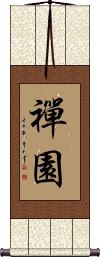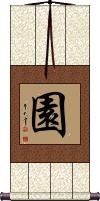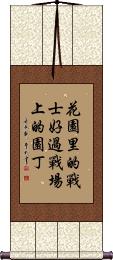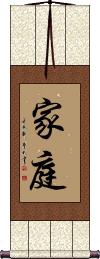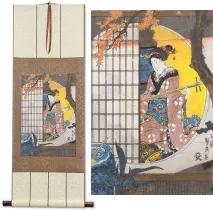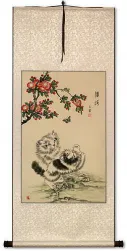Many custom options...
And formats...

Garden in Chinese / Japanese...
Buy a Garden calligraphy wall scroll here!
Personalize your custom “Garden” project by clicking the button next to your favorite “Garden” title below...
Zen Garden
禪園 literally means “meditation garden.”
The first character happens to be known as Zen in the west (the pronunciation comes from Japanese) but this title is not often used in Japan (won't be recognized as a Japanese title).
The title “Zen Garden” was made up by westerners I'm afraid.
Garden / Orchard / Park
園 is a single character that means garden in Chinese, Japanese Kanji, and old Korean Hanja.
This can also mean an orchard or park.
園 is not a common single character for a wall scroll but nothing is wrong with it. A lot of customers asked for a single character for a garden, so I've provided what I think is the best option here.
It is better to be a warrior in a garden than a gardener in a war
花園里的戰士好過戰場上的園丁 is the Chinese for the phrase, “It is better to be a warrior in a garden than a gardener in a war.”
This proverb is purported to come from the following exchange:
A student approaches his samurai master and says,
“Teacher, you instruct me how to fight, yet you preach to me about peace. How do I reconcile the two?”
The samurai responds,
“Because it is better to be a warrior in a garden than a gardener in a war.”
Family / Household
家庭/傢庭 is a common way to express family, household, or home in Chinese, Japanese Kanji, and old Korean Hanja.
However, for a wall scroll, we recommend the single-character form (which is just the first character of this two-character word). If you want that, just click here: Family Single-Character
The first character means “family” or “home.” The second means “courtyard” or “garden.” When combined, the meaning is a bit different, as it becomes “household” or “family.” The home and/or property traditionally has a strong relationship with family in Asia. Some Chinese, Korean, and Japanese families have lived in the same house for 7 or more generations!
This in-stock artwork might be what you are looking for, and ships right away...
Gallery Price: $60.00
Your Price: $36.88
Gallery Price: $108.00
Your Price: $59.88
Gallery Price: $126.00
Your Price: $69.88
Gallery Price: $144.00
Your Price: $79.88
These search terms might be related to Garden:
Thorns / Bramble / Briar Patch / Wild Rose
Not the results for garden that you were looking for?
Below are some entries from our dictionary that may match your garden search...
| Characters If shown, 2nd row is Simp. Chinese |
Pronunciation Romanization |
Simple Dictionary Definition |
園 园 see styles |
yuán yuan2 yüan sonomi そのみ |
More info & calligraphy: Garden / Orchard / Park(n,n-suf) (1) garden (esp. man-made); orchard; park; plantation; (2) place; location; (female given name) Sonomi vihāra; place for walking about, pleasure-ground, garden, park. |
莓 see styles |
méi mei2 mei ichigo いちご |
More info & calligraphy: Berry(out-dated kanji) (kana only) strawberry (esp. the garden strawberry, Fragaria x ananassa); (female given name) Ichigo |
鹿 see styles |
lù lu4 lu roku ろく |
More info & calligraphy: Deerdeer (esp. the sika deer, Cervus nippon); cervid; (personal name) Roku mṛga; a deer; as Śākyamuni first preached the four noble truths in the Deer-garden, the deer is a symbol of his preaching. |
釋迦牟尼 释迦牟尼 see styles |
shì jiā móu ní shi4 jia1 mou2 ni2 shih chia mou ni Shakamuni |
More info & calligraphy: Shakyamuni / The Buddha釋迦文 (釋迦文尼); 釋伽文 Śākyamuni, the saint of the Śākya tribe. muni is saint, holy man, sage, ascetic monk; it is: intp. as 仁 benevolent, charitable, kind, also as 寂默 one who dwells in seclusion. After '500 or 550' previous incarnations, Śākyamuni finally attained to the state of Bodhisattva, was born in the Tuṣita heaven, and descended as a white elephant, through her right side, into the womb of the immaculate Māyā, the purest woman on earth; this was on the 8th day of the 4th month; next year on the 8th day of the 2nd month he was born from her right side painlessly as she stood under a tree in the Lumbinī garden. For the subsequent miraculous events v. Eitel. also the 神通遊戲經 (Lalitavistara), the 釋迦如來成道記, etc. Simpler statements say that he was born the son of Śuddhodana, of the kṣatriya caste, ruler of Kapilavastu, and Māyā his wife; that Māyā died seven days later, leaving him to be brought up by her sister Prājapati; that in due course he was married to Yaśodharā who bore him a son, Rāhula; that in search of truth he left home, became an ascetic, severely disciplined himself, and finally at 35 years of age, under a tree, realized that the way of release from the chain of rebirth and death lay not in asceticism but in moral purity; this he explained first in his four dogmas, v. 四諦 and eightfold noble way 八正道, later amplified and developed in many sermons. He founded his community on the basis of poverty, chastity, and insight or meditation, ad it became known as Buddhism, as he became known as Buddha, the enlightened. His death was probably in or near 487 B.C., a few years before that of Confucius in 479. The sacerdotal name of his family is Gautama, said to be the original name of the whole clan, Śākya being that of his branch, v. 瞿, 喬.; his personal name was Siddhārtha, or Sarvārthasiddha, v. 悉. |
アンジェリカ see styles |
anjerika アンジェリカ |
More info & calligraphy: Anjelica |
圃 see styles |
pǔ pu3 p`u pu |
garden; orchard |
寺 see styles |
sì si4 ssu teraji てらじ |
Buddhist temple; mosque; government office (old) temple (Buddhist); (personal name) Teraji vihāra, 毘訶羅 or 鼻訶羅; saṅghārāma 僧伽藍; an official hall, a temple, adopted by Buddhists for a monastery, many other names are given to it, e. g. 淨住; 法同舍; 出世舍; 精舍; 淸淨園; 金剛刹; 寂滅道場; 遠離處; 親近處 'A model vihāra ought to be built of red sandalwood, with 32 chambers, 8 tāla trees in height, with a garden, park and bathing tank attached; it ought to have promenades for peripatetic meditation and to be richly furnished with stores of clothes, food, bedsteads, mattresses, medicines and all creature comforts.' Eitel. |
庭 see styles |
tíng ting2 t`ing ting niwasaki にわさき |
main hall; front courtyard; law court (1) garden; yard; courtyard; (2) field (of action); area; (surname) Niwasaki Court, hall, family; forehead. |
畑 see styles |
tián tian2 t`ien tien hatazaki はたざき |
used in Japanese names with phonetic value hatake, bata etc; dry field (i.e. not paddy field) (1) field (for fruits, vegetables, etc.); cultivated land; vegetable plot; kitchen garden; plantation; (n,suf) (2) field (of specialization); sphere; area; (3) (colloquialism) womb; birth; birthplace; field (for fruits, vegetables, etc.); cultivated land; vegetable plot; kitchen garden; plantation; (surname) Hatazaki |
畠 see styles |
hatano はたの |
(1) field (for fruits, vegetables, etc.); cultivated land; vegetable plot; kitchen garden; plantation; (n,suf) (2) field (of specialization); sphere; area; (3) (colloquialism) womb; birth; birthplace; field (for fruits, vegetables, etc.); cultivated land; vegetable plot; kitchen garden; plantation; (surname) Hatano |
祇 只 see styles |
qí qi2 ch`i chi tada |
god of the earth To revere, venerate; only; translit. j in 祇園精舍; 祇樹給孤獨園 The vihāra and garden Jetavana, bought by Anāthapiṇḍaka from prince Jeta and given to Śākyamuni.; The Earth-Spirit; repose; vast; translit. j, g. |
苑 see styles |
yuàn yuan4 yüan sono その |
(literary) enclosed area for growing trees, keeping animals etc; imperial garden; park; (literary) center (of arts, literature etc) (n,n-suf) (1) garden (esp. man-made); orchard; park; plantation; (2) place; location; (surname, female given name) Sono A park, imperial park, a collection: v. Jetavana 祇. |
苺 see styles |
méi mei2 mei mei / me めい |
variant of 莓, berry; strawberry (kana only) strawberry (esp. the garden strawberry, Fragaria x ananassa); (female given name) Mei |
院 see styles |
yuàn yuan4 yüan in いん |
courtyard; institution; CL:個|个[ge4] (1) (See 下院・かいん) house of parliament (congress, diet, etc.); (2) graduate school; postgraduate school; (suffix) (3) (See 医院・いいん,病院・びょういん) institution (often medical); institutional building; government office; (suffix) (4) {Buddh} sub-temple; minor temple building; temple; cloister; (5) (honorific or respectful language) imperial palace; (6) (honorific or respectful language) (hist) (See 女院・にょういん) title bestowed on empresses, princesses, etc.; (suffix) (7) former (esp. of emperors, daimyos, etc.); late; (surname, female given name) In ārāma, pleasaunce, garden, grove; a monastery, hall, court. |
鱧 鳢 see styles |
lǐ li3 li hamo はも |
snakefish; snakehead mullet (1) (kana only) daggertooth pike conger (Muraenesox cinereus); (2) (kana only) (thb:) (See 穴子) conger eel; garden eel; (surname, given name) Hamo |
ハモ see styles |
hamo ハモ |
(1) (kana only) daggertooth pike conger (Muraenesox cinereus); (2) (in Northern Japan) conger eel; garden eel |
ほ場 see styles |
hojou / hojo ほじょう |
cultivated land (field, garden, orchard, etc.) |
三照 see styles |
sān zhào san1 zhao4 san chao sanshō |
The three shinings; the sun first shining on the hill-tops, then the valleys and plains. So, according to Tiantai teaching of the Huayan sūtra, the Buddha's doctrine had three periods of such shining: (a) first, he taught the Huayan sūtra, transforming his chief disciples into bodhisattvas; (b) second, the Hīnayāna sūtras in general to śrāvakas and pratyeka-buddhas in the Lumbinī garden; (c) third, the 方等 sūtras down to the 涅槃經 for all the living. See the 六十華嚴經 35, where the order is five, i.e. bodhisattvas, pratyekabuddhas, śrāvakas, lay disciples, and all creatures. |
作庭 see styles |
sakutei / sakute さくてい |
(See 造園) creating a garden; landscape gardening |
侍弄 see styles |
shì nòng shi4 nong4 shih nung |
to look after; to tend (one's crops, garden, livestock, pets etc); to repair |
修整 see styles |
xiū zhěng xiu1 zheng3 hsiu cheng shuusei / shuse しゅうせい |
to spruce up; to renovate; to tend (a garden); to groom (one's hair); to finish (a rough surface); to trim (a lawn); to touch up (a photo) (noun, transitive verb) adjustment; retouching (in photography) |
借景 see styles |
shakkei / shakke しゃっけい |
making use of the surrounding landscape as a part of the design of a garden; natural scenery used as the background in the landscaping of a garden |
假山 see styles |
jiǎ shān jia3 shan1 chia shan |
rock garden; rockery |
入園 入园 see styles |
rù yuán ru4 yuan2 ju yüan nyuuen / nyuen にゅうえん |
to enter a park or other place for public recreation (typically, one whose name ends in 園|园: a zoo 動物園|动物园[dong4 wu4 yuan2], amusement park 遊樂園|游乐园[you2 le4 yuan2] etc); to enrol in a kindergarten 幼兒園|幼儿园[you4 er2 yuan2]; to start going to kindergarten (noun/participle) (1) enrollment in kindergarten; enrolment in kindergarten; (2) entering a park, garden, zoo, etc. |
入苑 see styles |
nyuuen / nyuen にゅうえん |
(irregular kanji usage) (noun/participle) (1) enrollment in kindergarten; enrolment in kindergarten; (2) entering a park, garden, zoo, etc. |
内池 see styles |
naichi ないち |
garden pond; (surname) Naichi |
内苑 see styles |
uchizono うちぞの |
inner garden; inner park; (surname) Uchizono |
出居 see styles |
dei / de でい |
(1) (archaism) sitting outdoors; (2) (See 寝殿造り) room that served both as a reception room and as a living room in a Heian-period mansion; (3) temporary sitting place installed in the garden at the imperial court, used on the occasion of archery or sumo ceremonies; (surname) Dei |
前庭 see styles |
qián tíng qian2 ting2 ch`ien t`ing chien ting maeniwa まえにわ |
front courtyard; vestibule (1) front garden; front yard; (2) (ぜんてい only) {anat} vestibule (of the ear); (surname) Maeniwa |
前栽 see styles |
senzai せんざい |
garden; trees and flowers in a garden; (place-name) Senzai |
Click here for more garden results from our dictionary
The following table may be helpful for those studying Chinese or Japanese...
| Title | Characters | Romaji (Romanized Japanese) | Various forms of Romanized Chinese | |
| Zen Garden | 禪園 禅园 | zen sono / zensono | chán yuán chan2 yuan2 chan yuan chanyuan | ch`an yüan chanyüan chan yüan |
| Garden Orchard Park | 園 园 | sono | yuán / yuan2 / yuan | yüan |
| It is better to be a warrior in a garden than a gardener in a war | 花園里的戰士好過戰場上的園丁 花园里的战士好过战场上的园丁 | huā yuán lǐ de zhàn shì hǎo guò zhàn chǎng shàng de yuán dīng huā yuán lǐ de zhàn shì hǎo guò zhàn chǎng shàng de yuán dīng ài wēng huā yuán lǐ de zhàn shì hǎo guò zhàn chǎng shàng de yuán dīng hua1 yuan2 li3 de zhan4 shi4 hao3 guo4 zhan4 chang3 shang4 de yuan2 ding1 hua1 yuan2 li3 de zhan4 shi4 hao3 guo4 zhan4 chang3 shang4 de yuan2 ding1 ai4 weng1 hua1 yuan2 li3 de zhan4 shi4 hao3 guo4 zhan4 chang3 shang4 de yuan2 ding1 hua yuan li de zhan shi hao guo zhan chang shang de yuan ding hua yuan li de zhan shi hao guo zhan chang shang de yuan ding ai weng hua yuan li de zhan shi hao guo zhan chang shang de yuan ding | hua yüan li te chan shih hao kuo chan ch`ang shang te yüan ting hua yüan li te chan shih hao kuo chan ch`ang shang te yüan ting ai weng hua yüan li te chan shih hao kuo chan ch`ang shang te yüan ting hua yüan li te chan shih hao kuo chan chang shang te yüan ting hua yüan li te chan shih hao kuo chan chang shang te yüan ting ai weng hua yüan li te chan shih hao kuo chan chang shang te yüan ting |
|
| Family Household | 家庭 / 傢庭 家庭 | ka tei / katei | jiā tíng / jia1 ting2 / jia ting / jiating | chia t`ing / chiating / chia ting |
| In some entries above you will see that characters have different versions above and below a line. In these cases, the characters above the line are Traditional Chinese, while the ones below are Simplified Chinese. | ||||
Successful Chinese Character and Japanese Kanji calligraphy searches within the last few hours...
